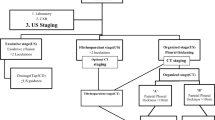Abstract
Objective : To evaluate the implications of a newly defined severity scoring of empyema in children for the prediction of surgical management and to compare the length of hospitalization as an outcome measure of patients treated using medical therapy, salvage video-assisted thoracoscopic surgery (VATS)vs early elective VATS.Methods : A retrospective chart review of parapneumonic empyema of patients below 18 years of age admitted to a tertiary children’s hospital in northern Taiwan from April 1993 to December 2002 was performed. Patients were categorized into a medical group who received antibiotic therapy, needle aspirations with/without tube thoracostomy; a salvage VATS group when the patients required surgery for the relief of persistent fever > 38°C, chest pains or dyspneic respirations despite initial medical therapy; an early VATS group when the patients received elective surgery early after admission. The demographic data, clinical features, laboratory findings, and duration of hospitalization were compared using a severity score of empyema (SSE).Results :Streptococcus pneumoniae was the most common infecting organism, followed byStaphylococcus aureus, Pseudomonas aeruginosa. No organisms were recovered in 39% of patients. A pleural pH < 7.1 increases the odds of requiring surgical intervention by 6 times among this cohort. Children who required decortication of empyema had a higher severity score (mean 4.8 vs 3.0, p < 0.005). The duration of hospitalization for patients having early VATS showed a shortening stay (mean 18 vs 28 days) as compared to salvage VATS.Conclusion : A pleural pH < 7.1 and a newly designed clinical severity score of empyema ≥4 are two predictors of surgical intervention for fibrinopurulent empyema in the present study. Early elective VATS may be adopted not later than 7 days after failure of appropriate antibiotic therapy and adequate drainage of empyema to decrease the length of stay and minimize morbidity.
Similar content being viewed by others
References
Galladay E, Wagner C. Management of empyema in children.Am J Surg 1989; 158: 618–621.
Khakoo GA, Goldstraw P, Hansell DM, Bush A. Surgical treatment of parapneumonic empyema.Pediatr Pulmonol 1996; 22:348–356.
Shankar KR, Kenny SE, Okoye BO, Carty HML, Losty PD. Evolving experience in the management of empyema thoracis.Acta Paediatr 2000; 89: 417–420.
Gocmen A, Kiper N, Toppare M, Ozcelik U, Cengizlier R, Cetinkaya F. Conservative treatment of empyema in children.Respiration 1993; 60:182–185.
Chan W, Keyser-Gauvin E, Davis GM, Nguyen LT, Laberge JM. Empyema thoracis in children: a 26-year review of the Montreal Children’s Hospital experience.J Pediatr Surg 1997; 32:870–872.
Thomson AH, Hull J, Kumar MR, Wallis C, Balfour Lynn IM. Randomized trial of intrapleural urokinase in the treatment of childhood empyema.Thorax 2002; 57: 343–347.
Balci AE, Eren S, Ülkü R, Eren MN. Management of multiloculated empyema thoracis in children: rhoracotomy versus fibrinolytic treatment.Eur J Cardio Thorac Surg 2002; 22: 595–598.
Hoff S, Neblett W, Edwards KM, Heller RM, Pietsch JB, Holcomb GW, Hocomb III GW. Parapneumonic empyema in children: decortication hastens recovery in patients with severe pleural infections.Pediatr Infect Dis J 1991; 10:194–199.
Grewal H, Jackson RJ, Wagner CW, Smith SD. Early videoassisted thoracic surgery in the management of empyema.Pediatrics 1999; 103: e63.
Subramaniam R, Joseph VT, Tan GM, Goh A, Chay OM. Experience with video-assisted thoracoscopic surgery in the management of complicated pneumonia in children.J Pediatr Surg 2001; 36: 316–319.
British Thoracic Society Research Committee: Community acquired pneumonia in adults in British hospitals in 1982-1983; A survey of aetiology, mortality, prognostic factors and outcome.QJ Med 1987; 62:195–200.
Torres A, Serra-Batlles J, Ferrer A, Jimenez P, Celis R, Cobo E, Rodriguez-Roisin R. Severe community-acquired pneumonia.Am Rev Respir Dis 1991; 144:312–318.
Ewig S, Bauer T, Hasper Eet al. Prognostic analysis and predictive rule for outcome of hospital-treated community acquired pneumonia.Eur Resp J 1995; 8: 392–397.
Liu HP, Hsieh MJ, Lu HI, Liu YH, Wu YC, Lin PJ. Thoracoscopic-assisted management of postpneumonic empyema in children refractory to medical response.Surg Endosc 2002; 16:1612–1614.
Wong KS, Chiu CH, Yeow KM, Huang YC, Liu HP, Lin CY. Necrotizing pneumonitis in children.Eur J Pediatr 2000; 159: 684–688.
Kennedy AS, Agness M, Bailey L, White JJ. Decortication for childhood empyema.Arch Surg 1991; 126:1287–1291.
Chen KY,LiawYS, Wang HQ Luk KT, Yang PC. Sonographic septation: a useful prognostic indicator of acute thoracic empyema.J Ultrasound Med 2000; 19: 837–843.
Ramnath RR, Heller RM, Ben-Ami T, Miller MA, Campbell P, Neblett III WW, Holcomb GW, Hernanz-Schulman H. Implications of early sonographic evaluation of parapneumonic effusions in children with pneumonia.Pediatrics 1998; 101:68–71.
Shankar S, Gulati M, Kang M, Gupta S, Suri S. Image-guided percutaneous drainage of thoracic empyema: can sonography predict the outcome?Eur Radiol 2000; 10: 495–499.
Rosen H, Nadkarni V, Theroux, Padman R, Klein J. Intrapleural streptokinase as adjunctive treatment for persistent empyema in pediatric patients.Chest 1993; 103: 1190–1193.
Cohen G, Hjortdal V, Ricci M, Jaffe A, Wallis C, Dinwiddie R, Elliott MJ, de Levai MR. Primary thoracoscopic treatment of empyema in children.J Thorac Cardiovasc Surg 2003; 125: 79–84.
Barbate A, Panizzolo C, Monciotti C, Marcucci F, Stefanutti G, Gamba PG. Use of urokinase in childhood pleural empyema.Pediatr Pulmonol 2003; 35: 50–55.
Krishman S, Amin N, Dozor AJ, Stringel G. Urokinase in the management of complicated parapneumonic effusions in children.Chest 1997; 112:1579–1583.
Kercher KW, Attorri RJ, Hoover JD, Morton D. Thoracoscopic decortication as first-line therapy for pediatric parapneumonic empyema-a case series.Chest 2000; 118:24–27.
Author information
Authors and Affiliations
Corresponding author
Rights and permissions
About this article
Cite this article
Wong, K.S., Lin, T.Y., Huang, Y.C. et al. Scoring System for Empyema Thoracis and Help in Management. Indian J Pediatr 72, 1025–1028 (2005). https://doi.org/10.1007/BF02724404
Issue Date:
DOI: https://doi.org/10.1007/BF02724404




